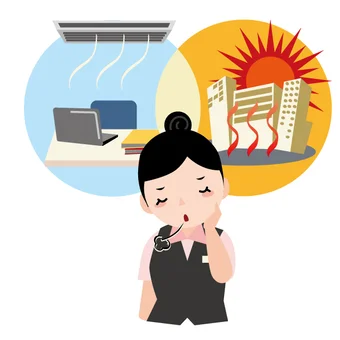Column Back Pain Caused by The Difference Between Outside & Inside Temperatures

June 17, 2023
Recently, we can notice that the temperature difference between the outside and the inside of the house or train has been on the increase.
The heat can typically be over 35° outside, but on trains and indoor, the average temperature is 25,6° due to air conditioners, so it is not unusual to have a temperature difference of more than 10° between the outside and the inside.
And there is a relationship between this “temperature difference” and “back pain” because the human body must maintain a constant body temperature even in the presence of such temperature differences.
It is the “autonomic nervous system” that is in charge of maintaining the body at a constant temperature.
During a busy, stressful, and tiring work schedule, adding temperature differences to the equation will result in fatigue of the autonomic nervous system.
This condition is called “temperature difference fatigue”. It is more likely to occur when the temperature difference is 5°C or more on several consecutive days.
The autonomic nervous system is mainly divided into the sympathetic nervous system and the parasympathetic nervous system, with the former being normally prevalent during the day and the latter being more active at night to maintain balance between the two.
If either of them is too active for some reason, the body will not perform well.
The sympathetic nerves are excited by differences in temperature. The sympathetic nervous system may cause muscle tension, vasoconstriction, increased blood pressure, increased heart rate, and shallow and rapid breathing.
This state of constant excitation may result in a sluggish blood flow and sustained muscle tension, which can be exhausting if sustained for some time.
The muscles of the lower back are subjected to many stimuli of the upper and lower body, and as such, it is a part of the body which also gets easily fatigued. When this is combined with the effects from the autonomic nervous system, the fatigue can accumulate even more. As a result, even a minor trigger can lead to back pain.
This is the actual relationship that exists between temperature differences and lower back pain.
Add to that that the lower back is also susceptible to internal organs fatigue and sensitivity to cold.
Try to incorporate the following easy steps in your daily routine:
(1) Warm up local areas of the body (muscles and internal organs).
(2) Exercising, such as taking walks (also recommended for heat adaptation. Be aware of the temperature around you and other factors when exercising).
(3) Stretch neck and shoulder muscles thoroughly.
(4) Eat plenty of foods that are known to warm the body.
(5) Adopt a regular lifestyle (with adequate sleep and exposure to the sun in the morning)
(6) Soak up in a hot bath up to the neck in a 38 to 40°Celsius hot water to warm the core of the body and the neck, where the autonomic nerves are concentrated. These nerves are also concentrated around the ears, so pinching the ears and pulling them back and forth is also an effective way of regulating the function of the autonomic nerves.
(7) Keep the difference in temperature within 3° of the outside temperature when adjusting the temperature by air conditioning, etc.
(8) Drink water frequently (be mindful of drinking enough to avoid dehydration).
(9) Eat summer vegetables to lower body temperature.
Back pain is more likely to occur during the transition period between seasons or when the difference in temperature is significant, so don’t forget to take care of yourself during this crucial period.



